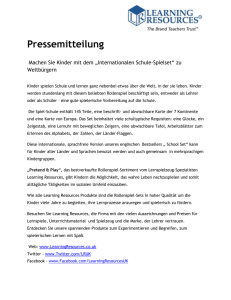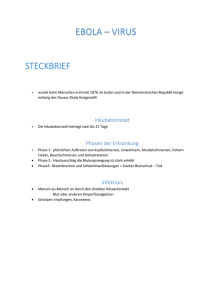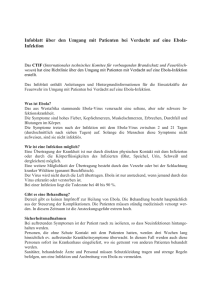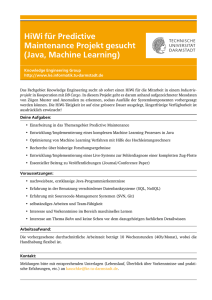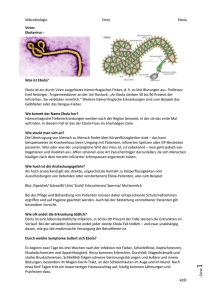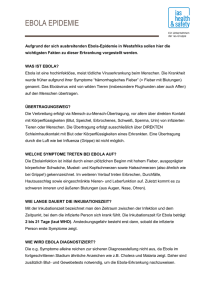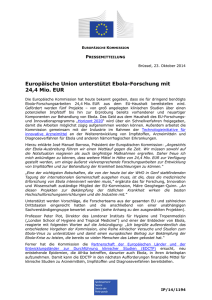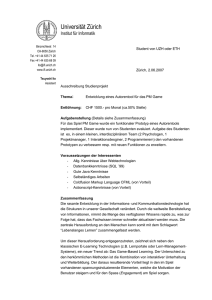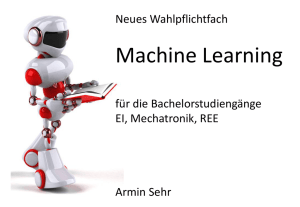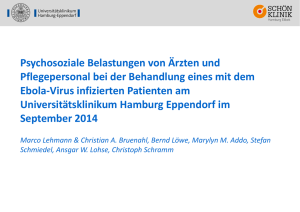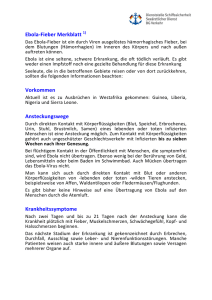BioS_2015_6_OE_Jahnke
Werbung
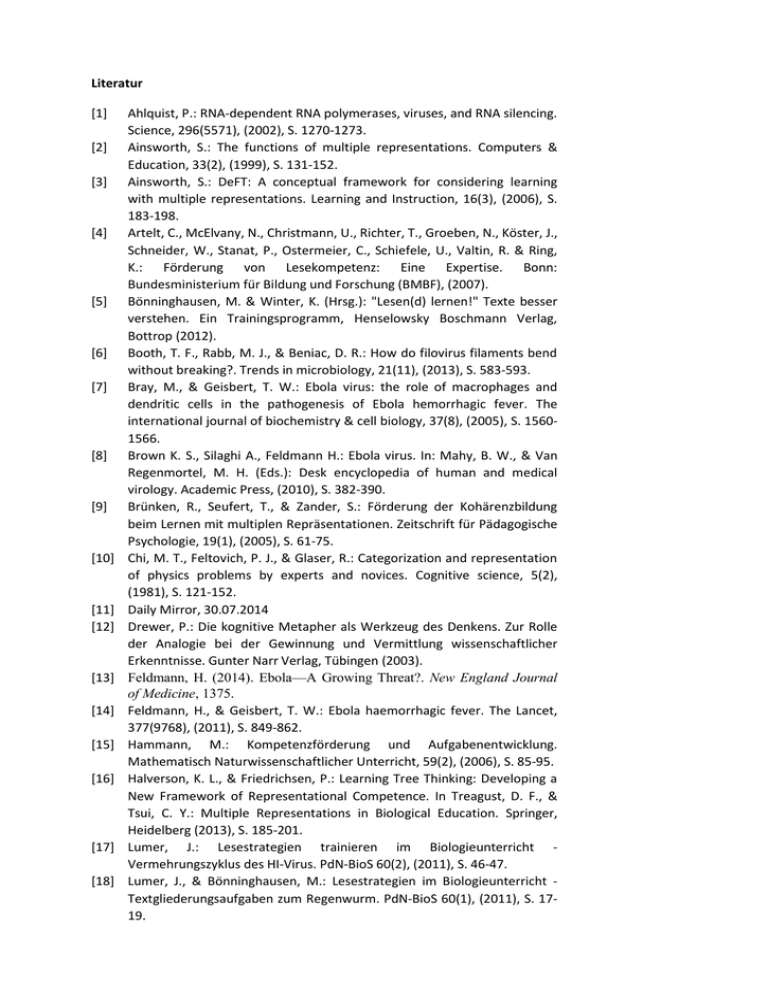
Literatur [1] [2] [3] [4] [5] [6] [7] [8] [9] [10] [11] [12] [13] [14] [15] [16] [17] [18] Ahlquist, P.: RNA-dependent RNA polymerases, viruses, and RNA silencing. Science, 296(5571), (2002), S. 1270-1273. Ainsworth, S.: The functions of multiple representations. Computers & Education, 33(2), (1999), S. 131-152. Ainsworth, S.: DeFT: A conceptual framework for considering learning with multiple representations. Learning and Instruction, 16(3), (2006), S. 183-198. Artelt, C., McElvany, N., Christmann, U., Richter, T., Groeben, N., Köster, J., Schneider, W., Stanat, P., Ostermeier, C., Schiefele, U., Valtin, R. & Ring, K.: Förderung von Lesekompetenz: Eine Expertise. Bonn: Bundesministerium für Bildung und Forschung (BMBF), (2007). Bönninghausen, M. & Winter, K. (Hrsg.): "Lesen(d) lernen!" Texte besser verstehen. Ein Trainingsprogramm, Henselowsky Boschmann Verlag, Bottrop (2012). Booth, T. F., Rabb, M. J., & Beniac, D. R.: How do filovirus filaments bend without breaking?. Trends in microbiology, 21(11), (2013), S. 583-593. Bray, M., & Geisbert, T. W.: Ebola virus: the role of macrophages and dendritic cells in the pathogenesis of Ebola hemorrhagic fever. The international journal of biochemistry & cell biology, 37(8), (2005), S. 15601566. Brown K. S., Silaghi A., Feldmann H.: Ebola virus. In: Mahy, B. W., & Van Regenmortel, M. H. (Eds.): Desk encyclopedia of human and medical virology. Academic Press, (2010), S. 382-390. Brünken, R., Seufert, T., & Zander, S.: Förderung der Kohärenzbildung beim Lernen mit multiplen Repräsentationen. Zeitschrift für Pädagogische Psychologie, 19(1), (2005), S. 61-75. Chi, M. T., Feltovich, P. J., & Glaser, R.: Categorization and representation of physics problems by experts and novices. Cognitive science, 5(2), (1981), S. 121-152. Daily Mirror, 30.07.2014 Drewer, P.: Die kognitive Metapher als Werkzeug des Denkens. Zur Rolle der Analogie bei der Gewinnung und Vermittlung wissenschaftlicher Erkenntnisse. Gunter Narr Verlag, Tübingen (2003). Feldmann, H. (2014). Ebola—A Growing Threat?. New England Journal of Medicine, 1375. Feldmann, H., & Geisbert, T. W.: Ebola haemorrhagic fever. The Lancet, 377(9768), (2011), S. 849-862. Hammann, M.: Kompetenzförderung und Aufgabenentwicklung. Mathematisch Naturwissenschaftlicher Unterricht, 59(2), (2006), S. 85-95. Halverson, K. L., & Friedrichsen, P.: Learning Tree Thinking: Developing a New Framework of Representational Competence. In Treagust, D. F., & Tsui, C. Y.: Multiple Representations in Biological Education. Springer, Heidelberg (2013), S. 185-201. Lumer, J.: Lesestrategien trainieren im Biologieunterricht Vermehrungszyklus des HI-Virus. PdN-BioS 60(2), (2011), S. 46-47. Lumer, J., & Bönninghausen, M.: Lesestrategien im Biologieunterricht Textgliederungsaufgaben zum Regenwurm. PdN-BioS 60(1), (2011), S. 1719. [19] Misasi, J., & Sullivan, N. J.: Camouflage and Misdirection: The Full-On Assault of Ebola Virus Disease. Cell, 159(3), (2014), S. 477-486. [20] Niegemann, H. M., Domagk, S., Hessel, S., Hein, A., Hupfer, M., & Zobel, A.: Kompendium multimediales Lernen. Springer, Berlin (2008). [21] Peeck, J.: Enhancing graphic-effects in instructional texts: Influencing learning activities. Advances in psychology, 108, (1994), S. 291-301. [22] Schlag, S.: Kognitive Strategien zur Förderung des Text-und Bildverstehens beim Lernen mit illustrierten Sachtexten: theoretische Konzeptualisierung und empirische Prüfung (Vol. 19). Logos Verlag, Berlin (2011). [23] Schlag, S., & Ploetzner, R.: Supporting learning from illustrated texts: Conceptualizing and evaluating a learning strategy. Instructional Science, 39(6), (2011), S. 921-937. [24] Schnotz, W.: Wissenserwerb mit Multimedia. Unterrichtswissenschaft, 29(4), (2001), S. 292-318. [25] Schnotz, W.: An integrated model of text and picture comprehension. In Mayer, R.: The Cambridge handbook of multimedia learning, (2005), S. 4969. [26] Schnotz, W., & Bannert, M.: Einflüsse der Visualisierungsform auf die Konstruktion mentaler Modelle beim Text- und Bildverstehen. In: Zeitschrift für Experimentelle Psychologie 46(3), (1999), S. 217-236. [27] Schnotz, W., & Bannert, M.: Construction and interference in learning from multiple representations. In: Learning and Instruction 13(2), (2003), S. 141-156. [28] Spiegel, Heft 39/2014 (22.09.2014) [29] Treagust, D. F., & Tsui, C. Y.: Multiple Representations in Biological Education (Vol. 7). Springer, Heidelberg (2013). [30] Weidenmann, B.: When good pictures fail: An information-processing approach to the effects of illustrations. In: Mandl, H., Levin, J. R.: Knowledge acquisition from text and pictures. Elsevier, Amsterdam (1989), S. 157-170. [31] White, J. M., & Schornberg, K. L.: A new player in the puzzle of filovirus entry. Nature Reviews Microbiology, 10(5), (2012), S. 317-322. [32] www.who.int/mediacentre/factsheets/fs103/en/Spiegel 39/2014 (Zugriffsdatum: 26.04.2015) [33] www.wn.de/Muensterland/1792875-Joachim-Gardemann-leitet-in-SierraLeone-ein-Behandlungszentrum-vom-Roten-Kreuz-und-Roten-HalbmondEbola-verzeiht-keinen-Fehler (Zugriffsdatum: 26.04.2015) [34] www.edition.cnn.com/2014/10/15/health/ebola-fears/ (Zugriffsdatum: 26.04.2015) [35] www.virology.ws/2014/11/25/how-zmapp-antibodies-bind-to-ebolavirus/ (Zugriffsdatum: 26.04.2015) [36] www.medizin.de/ratgeber/ebola-wirkstoff-zmapp.html (Zugriffsdatum: 26.04.2015) [37] www.daserste.de/information/wissen-kultur/w-wiewissen/sendung/ebola-typisierung-100.html (Zugriffsdatum: 26.04.2015)

